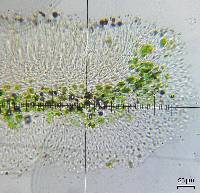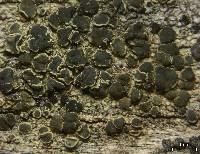
Consortium of Lichen Herbaria
- building a Global Consortium of Bryophytes and Lichens as keystones of cryptobiotic communities -
- Home
- Search
- Images
- Species Checklists
- US States: O-Z >
- US National Parks
- Central America
- South America
- US National Parks
- Southern Subpolar Region
|
|
|
|
Family: Lecanoraceae
|
Nash, T.H., Ryan, B.D., Gries, C., Bungartz, F., (eds.) 2004. Lichen Flora of the Greater Sonoran Desert Region. Vol 2. Thallus: crustose, poorly developed or weakly areolate areoles: ±isodiametric in outline, moderately convex, ecorticate but sometimes with a loose unorganised alga-free layer of various hyphae surface: yellowish beige, dull, esorediate Apothecia: rounded to flexuose, single or densely crowded, sessile with a strongly constricted base, 0.50-0.75(-0.90) mm in diam. disc: beige to ochre or orange-brown, often in parts olivaceous or pinkish gray, concave or flat to weakly convex, dull, white pruinose margin: yellowish white to beige, slightly lighter than disc, strongly prominent when young, persistent, ±crenulate, without a parathecial ring amphithecium: present, with an algal layer, laterally 45-120 µm, basally 75-160 µm wide, medulla and sometimes also cortex filled with brownish granules (soluble in K), medulla with irregularly entangled, short-celled hyphae with lumina 1-2 µm wide, corticate; cortex: composed of strongly gelatinized, anti-clinally arranged hyphae with lumina of 1.5-4.5 µm, 5-20 µm wide above, 20-45 µm near base parathecium: missing or present and 10-20 µm wide epihymenium: ochre to reddish brown, finely granular (soluble in K), 5-15(-20) µm thick hymenium: hyaline to pale brown, (35-)4060 µm tall; paraphyses: simple or weakly branched and anastomosing, 1-1.5 µm wide below, 1-2(-2.5) µm wide apically; subhymenium: hyaline, 15-55(-90) µm thick; hypothecium: hyaline or pale yellow or brown, 5-75 µm thick asci: clavate, 8-spored ascospores: hyaline, simple, ellipsoid, (6.5-)7.8-9.6(-12) x (3.5-)4.1-6.1(-7.5) µm Pycnidia: not observed Spot tests: thallus and apothecia K-, C-, KC-, P- Secondary metabolites: usnic acid, ±isousnic acids, ±1-5 terpenoids (incl. zeorin). Substrate and ecology: mostly endosubstratal, on twigs and bark of trees and chaparral plants World distribution: western North America Sonoran distribution: southern California between 1250-2100 m. Notes: Typical specimens of Lecanora laxa are characterized by large, basally strongly constricted and flexuose apothecia. Lecanora coniferarum and L. saligna have less constricted apothecia. Lecanora saligna is also distinguished by narrowly ellipsoid spores, an amphithecial cortex of more or less equal thickness and isousnic acid as the only secondary product. Two collections growing on wood between sea-level and 660 m, and characterized by relatively long spores may represent a different taxon. |
|
|
|
Powered by Symbiota


















































